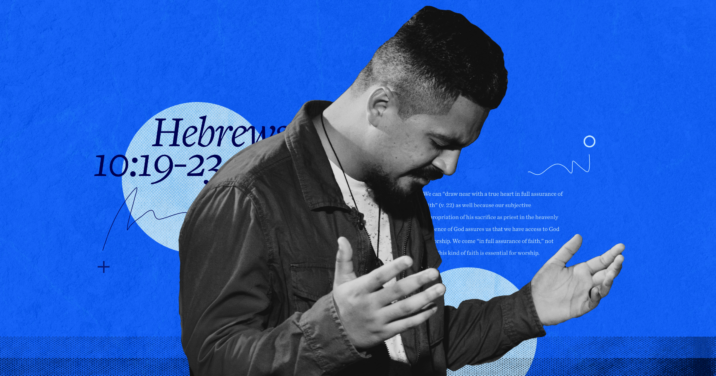The author of Hebrews presents us with vivid imagery of Old Covenant worship in the tabernacle/temple, its priests, and the sacrifices they offered. But what, if anything, does this have to do with my worship as a Christian? Do we still worship in a temple? Do we have a priesthood? Didn’t God accept Jesus’s sacrifice as the last one? How does the teaching in Hebrews connect to us today?
In our age, the Old Testament can seem irrelevant and meaningless—even weird! Because of this, even believers hesitate to dive in. But Christianity is “weird,” as Tom Holland says—and that’s okay!1 In fact, in this “weirdness,” we find life and meaning.
Hebrews is a practical letter with a deep theological foundation. Reading it is like diving off a ten-meter platform—challenging but exhilarating! Let’s dive in and be exhilarated by one passage in particular: What does Hebrews 10:19–22 teach us about worship? What we’ll find are deep truths that encourage our worship today: The New Covenant believer has confidence to enter the heavenly and holy presence of almighty God because of the mediation of the crucified Messiah and Savior, Jesus.
Table of contents
The context of Hebrews 10:19–22
Verse 19 roots our passage in its context, beginning with, “Therefore.” So let’s begin by uncovering Hebrew’s argument leading up to 10:19–22.
The pastoral concern: Keep running the race
The great practical question of Hebrews is why keep running the race? (Heb 12:1).2.
I take the position that Hebrews’ recipients were Jewish believers in Jesus—hence, why it’s called Hebrews. Temptations surrounded these Jewish believers in Jesus to forsake him as Messiah. After baptism, they “endured a hard struggle with sufferings” (10:32), including public reproach, affliction, imprisonment, ostracism from Jewish and Roman neighbors, and even the plundering of their property (10:33; 10:34; 13:3; 13:14).
Thus, God called them to live “outside the camp” in shame (13:13). Because of this, their faith was like “drooping hands,” “weak knees,” and “lame … out of joint” feet (12:12, 13). They needed the “great cloud of witnesses” to encourage them to “run with endurance … looking to Jesus … who for the joy that was set before him endured the cross, despising the shame” (12:1, 2).
The theological conviction: Jesus is better
What’s the deep theological basis for this practical exhortation? Jesus is better (1:4; 6:9; 7:19, 22; 8:6; 9:23; 10:34; 11:16, 35, 40; 12:24). The writer spends close to ten full chapters belaboring this point.

Compile each instance of Hebrews’ use of the word translated “better” with a simple search in Logos.
We must understand the language of “better” within the context of Hebrews’ argument. The author isn’t making the case that the Jews are an afterthought or that the Old Testament religion is worthless. Remember, the writer is speaking to Jews using their own Scriptures. “Better” means, “better in relation to the Old Testament.”
The Old Testament is full of types and “shadows” (8:5; 9:23; 10:1) which find their reality in Jesus.3 The writer calls the reality to which they pointed “the good things to come” (9:11; 10:1). Everything in the ancient Scriptures—from paradise to the patriarchs, prophecies, and pictures of priests, sacrifices, and temple—foreshadowed their reality to come.
Jesus is better than:
- Angels, who delivered the Law upon Mount Sinai (1:4; 2:1–4)
- Moses, who received the Law from those angels upon Mount Sinai (3:1–6)
- Priests, whom that Law established (4:14–5:10; 6:13–7:29)
- The tabernacle and later temple (8:1–9:28)4
- The sacrifices (9:6–10:18)
- The Old Covenant (8:6–13)
Everything in the ancient Scriptures—from paradise to the patriarchs, prophecies, and pictures of priests, sacrifices, and temple—foreshadowed their reality to come.
Jesus is better! And since Jesus is better, he’s worthy of our following him in the race of faith—including our worship.
The communal calling: superior worship
Because Jesus is better, our worship is better. We have a better priest, sacrifice, tabernacle/temple, and covenant.
But what is worship? According to Hebrews—as well as the rest of scripture—this “better worship” is the grateful response of the priesthood of believers in which they offer themselves to God as living sacrifices—heart, soul, mind, and strength—in the heavenly temple (see Heb 12:28–29; 13:15; Rom 12:1–2; Matt 22:34–40).
Importantly, worship is our response to God. Before we even say a word about our service to God, we must say that in the first place, God has served us. God made us to share in his life and love, and he redeemed us. As a result, our entire lives are to be rendered back to him in service.
At the same time, worship also occurs in a more particular way through the acts, ceremonies, and practices that God has graciously given us for this purpose: Word, sacraments, and prayer. God gracious serves us by speaking his final revelation of Word and sacraments that more clearly seal the promises of the New Covenant. We serve him back with a sacrifice of prayer.5
The Argument of Hebrews 10:19–22
After over nine chapters saying Jesus is better, our author reaches this major transitional point in his letter: 10:19–22. In it we learn what this better worship looks like.
A newfound confidence (10:19b)
First, we learn that New Covenant believers have a newfound confidence to worship. Notice how verse 19 speaks of our confidence: “Since we have confidence.” In other words, we already have it!
How can he say this? As the author often does, he is comparing and contrasting the Old and New Covenants.
The Lord’s meeting with his people at Mount Sinai displays the lack of confidence that, in contrast, characterizes Old Covenant worship. God commanded a boundary be placed around Mount Sinai. If anyone or animal crossed it and touched even the base of the mountain, they would die (Exod 19:12–13). A great lightning, thunderstorm, and thick cloud covered the top of the mountain, causing Israel to tremble and stand at a distance (Exod 19:16—18; 20:18). Only Moses drew near (Exod 20:19—21). Even still, Hebrews 12:21 says, “so terrifying was the sight that Moses said, ‘I tremble with fear’”(emphasis added).
God would likewise apply comparable restrictions to the tabernacle and temple. General worshippers could only come into the courtyard and stand at a distance from God’s presence. The priests alone could enter the first room (or Holy Place) of the tabernacle and temple. The high priest alone could enter the Holy of Holies, and only once a year. Hebrews 10:1 states one of the reasons: “the law has but a shadow of the good things to come”; therefore, it “can never … make perfect those who draw near.” In other words, even the God-ordained sacrifices of the Law were unable to grant worshippers confidence to approach the very presence of God.
But now we have “confidence” (10:19). Using this same word, Hebrew 4:16 explains the reason for this confidence: New Covenant worshippers have “confidence” to “draw near to the throne of grace” (4:16) for three reasons:
- We have a high priest (4:14a)
- Our high priest has passed through the heavens into God’s presence (4:14b)
- Our high priest sympathizes with our weaknesses (4:15)
Similarly, Paul says that in Jesus the Messiah, “we have boldness and access [to God] with confidence through our faith in him” (Eph 3:12).
In summary, Hebrews 10:19–22 teaches that, because of Jesus, all New Covenant believers have the confidence that God accepts them before his heavenly throne of grace.
To enter God’s presence (10:19c)
Secondly, we learn that New Covenant believers are welcomed to enter God’s presence. “We have confidence to enter the holy places” (v. 19), which is the author’s way of describing the tabernacle and temple’s Holy of Holies.
But how do we enter the Holy of Holies? Since AD 70, there has been no earthly temple in Jerusalem. Is the writer saying that we are waiting for it to be rebuilt so that we can enter at a later date? No.
Again, he’s comparing and contrasting the Old with the New. All the Old Covenant institutions of worship—including the tabernacle and later temple—were shadows of their reality to come. The ultimate reality cast a shadow. But now we have confidence to enter the reality itself, God’s very own presence!
Hebrews describes the “presence of God” (9:24; see also 7:19) with various images:
- Throne: “the throne of grace” (4:16); “the right hand of the throne of the Majesty in heaven” (8:1)
- Tent/tabernacle: his presence is “found” in “the true tent” (8:2); “the greater and more perfect tent” (9:11)
- Holy of Holies in that tent/tabernacle: “the holy places (8:2; 9:12)
- Celestial city on a mountain: “Mount Zion and to the city of the living God, the heavenly Jerusalem” (12:22)
- Heaven: “the heavenly things” (8:5; 9:23); “the true things … heaven itself” (9:24)
Explore the different elements of the tabernacle using Logos’s infographics.
This means that while Christian worship is detached from the earthly tabernacle and later temple in Jerusalem, it is still temple worship. Our temple is the heavenly reality of those ancient houses—God himself. When John was given a glimpse of the New Jerusalem, he said, “I saw no temple in the city, for its temple is the Lord God the Almighty and the Lamb” (Rev 21:22; emphasis added).
While Christian worship is detached from the earthly tabernacle and later temple in Jerusalem, it is still temple worship.
You and I get to enjoy what our ancient forefathers and foremothers longed to experience. You and I get to serve in a priesthood better than anything that the Old Testament priests could have imagined!
By means of the Messiah’s mediation (10:19d–21)
The third thing we learn is that New Covenant believers have confidence in worship to enter God’s presence by means of the Messiah’s mediation. We have “confidence to enter the holy places by the blood of Jesus” (v. 19; emphasis added).
What does he mean? Was the author saying that Jesus could have just had some of his blood drawn and that would’ve been sufficient? No, it’s a shorthand way of expressing what he says in the very next sentence. Observe its parallel in verse 20: “by the new and living way that he opened for us through the curtain, that is, through his flesh” (v. 20). We have confidence to draw near to God’s presence through Jesus’s death for us.
What does Hebrews 10:19–22 teach us about Jesus’s role in New Covenant worship? He’s the high priestly Mediator of it all. As verse 21 says, Jesus is our “great priest over the house [or temple] of God.” As our crucified high priest, he offered the once-for-all final sacrifice upon the altar in the heavenly temple. Hebrews describes his flesh as the curtain that separated the Holy of Holies from everything else in the temple. In our worship, then, we go through Jesus with confidence to God’s Presence: “let us draw near with a true heart in full assurance of faith” (v. 22).
We oftentimes use the phrase “the finished work of Christ” to mean he has accomplished all that is necessary for our redemption; there is no other way to God (John 14:6; Acts 4:12). The author applies his objective accomplishment to our worship: His sacrifice in the heavenly presence of God created access to God for us, and there is no other way to approach God’s presence except through him.
So, what does this mean for our actions of public service? Do we still need to offer blood sacrifices? No. Hebrews drives home that all the sacrifices of the Old Covenant were types (9:9–10; 10:1–4) of the final sacrifice of the final high priest (9:11–15, 18, 22; 10:17). Even more, the Old Covenant sacrifices were offered continually (10:1, 11) by sinful men who died (5:1–3; 7:23–25). They offered merely the blood of bulls and goats (10:4) in the earthly tabernacle (9:1). But Christ gave himself as a sacrifice once (10:12), with his own blood (9:12), and in the heavenly tabernacle (9:24). Earlier in 9:9–10, our author said the Old Covenant sacrifices could not cleanse the inward conscience of worshippers. In contrast, the blood of Christ does just that (9:13–14).
For this reason, historic Protestant Christian worship emphasizes the once-for-all objective accomplishment of Jesus’s sacrifice in acts of worship. For example, “old school” Protestant worship opens with a prayer of confession and absolution from the minister.6 In addition, preaching and the frequent celebration of the Lord’s Supper also emphasize this once-for-all sacrifice.
As those cleansed (10:22)
But how can I approach God “in full assurance of faith” (v. 22)—not fear—as is essential for worship? What if I’m not “feeling it”? What if I’m living with doubt or my conscience accuses me? How do I know the objective work of Jesus was accomplished for me?
We achieve access to God in worship through Christ’s objective work in the heavenly presence of God. But, as the author continues, we gain assurance of that access as we subjectively appropriate Christ’s priestly sacrifice.
Notice how Hebrew describes this “draw[ing] near with a true heart in full assurance of faith” in terms of baptism (v. 22), including both the inward (“hearts”/“conscience”) and the outward (“bodies” being “washed”).7 In other words, we subjectively appropriate Christ’s objective accomplishment through this sign and seal of holy Baptism.
The Christian life is a continual remembering of our baptism; this bolsters our confidence to draw near to the presence of God through Christ’s mediation. As Martin Luther said, “A Christian life is nothing else than a daily baptism, begun once and continuing ever after. … Therefore let all Christians regard their baptism as the daily garment that they are to wear all the time.”8
Or John Calvin:
Therefore, as often as we fall away, we ought to recall the memory of our baptism and fortify our mind with it, that we may always be sure and confident of the forgiveness of sins. For, though baptism, administered only once, seemed to have passed, it was still not destroyed by subsequent sins. For Christ’s purity had been offered us in it; his purity ever flourishes; it is defiled by no spots, but buries and cleanses away all our defilements.9

Launch your own study of Hebrews 10:19–22 using Logos’s Factbook.
Worship on earth as it is in heaven
How does the deep theological foundation of Hebrews 10:19–22 encourage believers in the practice of worship? The New Covenant believer has confidence to enter the heavenly and holy presence of Almighty God through the mediation of their crucified Messiah and Savior, Jesus.
We can identify at least two implications for how this call to “draw near” (v. 22) should shape our approach to worship:
1. Because worship is entering the heavenly and holy presence of God, our worship here on earth is transcendent.
We must have a vision of worship that is otherworldly. What we do in worship is bigger than us and our preferences. What we experience in worship can’t fully be grasped, especially by unbelievers. What happens in worship should have a degree of mystery that we cannot quantify in our weekly worship planning meetings. It’s weird and that’s okay.
2. Because worship is entering the heavenly and holy presence of God, our worship here on earth should be reverent.
When people cross the threshold into the worship space, it should be different than anything else they can get in the world the other six days. We can read the Word and pray all week, but there’s something different about gathering together. Jesus made us members of a holy priesthood who worship a holy God, in a holy way, with holy words, on a holy day.
Since you and I have this confidence to enter God’s heavenly and holy presence through the mediatory work of Jesus, let’s dive in by drawing near!
Resources Daniel R. Hyde recommends
A Commentary on the Epistle to the Hebrews (New International Commentary | NIC)
Regular price: $32.99
Enter His Courts With Praise!: Old Testament Worship For The New Testament Church
Regular price: $28.99
Related articles
- Heaven Invades Earth: Understanding the Symbolism & Purpose of the Tabernacle
- The Incarnation in the Bible: God’s True Tabernacle
- What’s Typology? Patterns of Creation in Redemptive History
- Liturgy as Gospel: My Journey Toward Christ-Centered Worship
- What It Means to “Worship in Spirit and Truth”: Exploring the Depths
- “Tom Holland to Christians: Preach the Weird Stuff!” Speak Life, October 25, 2019. https://www.youtube.com/watch?v=_gG_adjdx9w.
- All quotations are from the ESV.
- See my brief article, “What Is the Covenant of Grace?” TableTalk, Sept. 26, 2014. https://www.ligonier.org/learn/articles/what-covenant-grace.
- On the tabernacle, see my God in Our Midst: The Tabernacle and Our Relationship with God (Reformation Trust Publishing, 2012).
- For more on worship, see my What to Expect in Reformed Worship: A Visitor’s Guide, 2nd ed. (Wipf & Stock, 2013).
- On the history of absolution in Reformed liturgy, see my “Lost Keys: The Absolution in Reformed Liturgy,” Calvin Theological Journal 46, no. 1 (April 2011): 140–66. https://www.academia.edu/35514237/Lost_Keys_The_Absolution_in_Reformed_Liturgy?source=swp_share.
- It’s texts like this where classic Christian theology gets the language of “sacraments” as outward signs (the washing of the body) and the inward thing signified (the sprinkling of the conscience).
- Martin Luther, The Large Catechism, in The Annotated Luther, vol. 2: Word and Faith, ed. and trans. Kirsi I. Sterna (Fortress Press, 2015), 399, 401.
- John Calvin, Institutes of the Christian Religion, ed. John T. McNeill, trans. Ford Lewis Battles, 2 vols. (Westminster Press, 1960), 4.15.3.





